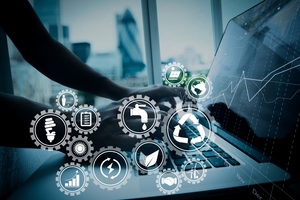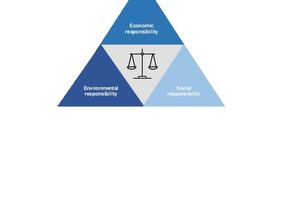Sustainable business and work
What does sustainability mean to us? This is a question that companies need to address – partly because the consequences of climate change are becoming increasingly tangible around the world.
When people and organizations talk about sustainability, they often refer to the three-pillar model. Behind this is the realization that the long-term stable development of societies is only possible if ecological, economic and social (development) goals are given equal priority.
This line of thinking can also be found in the United Nations’ 2030 Agenda, which was adopted in 2015. It formulates 17 global goals for sustainable development, the so-called Sustainable Development Goals (SDGs). They are intended to guide all governments, societies and companies worldwide in their future actions (see box).
When it comes to the topic of “sustainable development”, interests diverge
Such a guideline is necessary because in the social discourse it is disputed what is meant by “sustainable development” and how this goal can be achieved. Therefore, companies dealing with the topic of sustainability should first ask themselves what these terms mean to them and achieve a commitment on this. In doing so, decision-makers must be aware that their organization is embedded in an environment that has specific expectations of them; moreover, that the expectations of the various stakeholders such as customers, employees, suppliers, capital and legislators are changing and often diverge. For only if a company knows the various expectations can it decide: Which ones do we want to, can we, and must we respond to?
This in turn requires clarification: Why do we concern ourselves with the topic at all? Are we doing this out of our own intrinsic motivation – for example, because we ourselves are convinced that sustainable management and operation is necessary for survival? Or is the opposite the case? Are we primarily concerned with it because we are compelled to do so – for example
because the raw materials needed for our production are becoming increasingly scarce and expensive, or
because the legislator is forcing us to do so more and more, or
because the criterion of “sustainability” is becoming increasingly relevant to our customers‘ purchasing decisions
Knowing the sources of one’s own motivation is important because this influences
how consistently the company questions its previous thinking and actions, and
how holistic, in the sense of the 3-pillar model, the solutions envisaged or practiced are
Question: What are our goals in dealing with the topic?
In the past, for example, many production companies dealt with the issue of sustainability primarily from an efficiency perspective. They asked themselves, for example: How can we produce the same as before with fewer resources? And quite a few retail companies were primarily concerned with the issue of sustainability because it had become an important purchasing argument for their target customers. They hoped to gain a competitive advantage by selling products that were produced in an environmentally friendly manner and/or whose manufacture also took into account aspects such as animal welfare and fair payment to raw material suppliers (fair trade), and not infrequently even saw this as an opportunity to “upgrade” their products and achieve higher profits.
In the future, such a one-dimensional approach to the topic of sustainability will usually no longer be sufficient to meet market requirements and secure the existence of companies in the long term. This thesis is not a bold one when one sees how in many industries the topic of sustainability is already forcing all providers to fundamentally question their previous strategies and redefine their business field – for example, in the automotive industry and in the energy sector. This is also because one topic has become the central driver in the sustainability debate that only a few years ago played a rather marginal role in the area of environmental protection: climate change.
As the consequences of climate change become more and more tangible around the world, you don’t have to be a prophet to predict: In the coming years, climate change will be seen by a growing proportion of the population as a massive threat to human life. This will also further change customers‘ thinking and buying behavior. In addition, politicians will be forced to intervene in a more regulatory manner. It is therefore foreseeable: Business will be confronted with increasingly stringent requirements in the area of environmental and climate protection. In addition, more of the companies’ top performers – i.e., people on whose know-how, skills and commitment they depend – will ask their employer to what extent the latter is working in a climate- and environmentally friendly manner and is contributing to the achievement of sustainability goals. In the future, therefore, companies will have to address the issue of sustainability more holistically in the sense of the three-pillar model and undergo the necessary transformation processes if they want to secure their existence sustainably.
A rethink has taken place on the executive floors of many companies
This awareness is also increasingly growing on the executive floors of companies. That is why a growing number of corresponding projects are taking place in them. In them, the sustainability goals formulated by the United Nations often serve as a basis for reflection:
What does sustainable business and work mean for us?
How is this reflected in our day-to-day work in all our business areas and processes?
What development goals are associated with this for our part – economically, ecologically and socially? And:
What changes are necessary for this in our organization at the cultural, structural and process levels?
The results are then used to derive sustainability concepts and, in turn, change and transformation projects. In addition, more and more companies are setting up cross-divisional and cross-functional project groups to continuously develop the sustainability concept, because ultimately, when it comes to sustainable development and sustainable business and work, we are currently all still learning or searching for the promising path.




